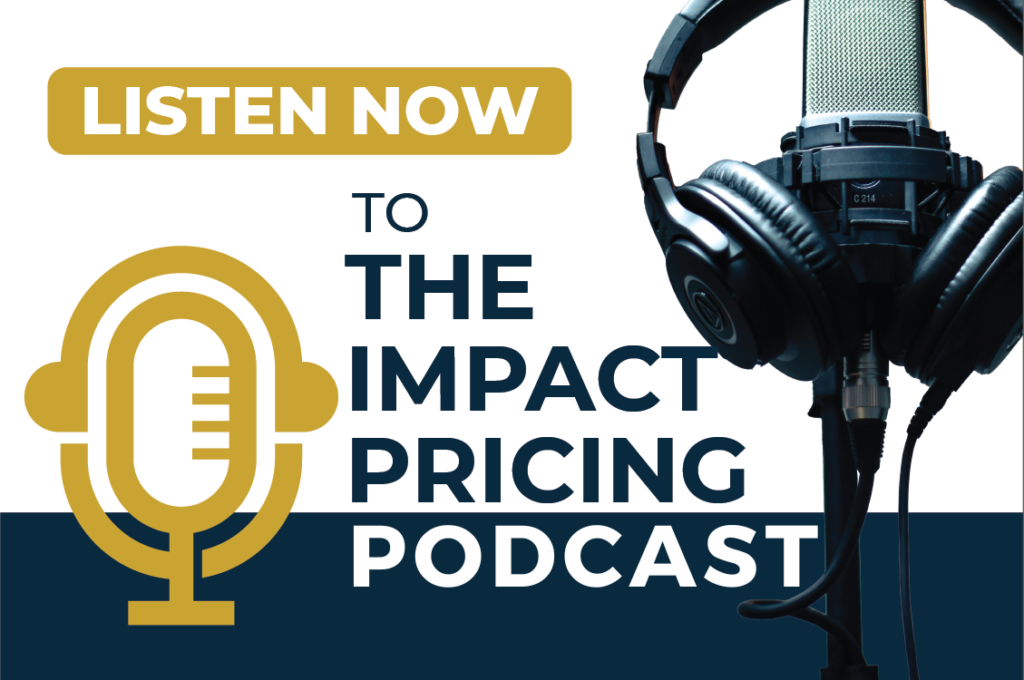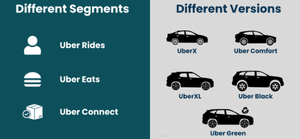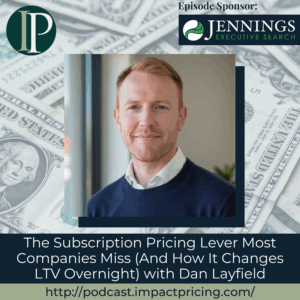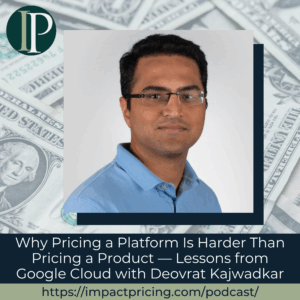Mike Wilkinson is referred to as The Value Sales Expert whose focus is on value and value selling.
In this episode, Mike shares what is involved in a successful value-based selling to enable tailored solutions that address specific challenges of your customers. He emphasizes the importance of measuring and reinforcing delivered value while developing ongoing relationships to uncover new opportunities and ensure long-term success.
Podcast: Play in new window | Download
Why you have to check out today’s podcast:
- Learn about a five-step value-based selling framework to help you master value-based selling and deepen customer relationships.
- Gain Insights from real-world perspectives, practical advice, and candid reflections on overcoming common sales challenges.
- Discover how to shift from a product-first to a customer-first mindset and transform your sales approach.
“The most important thing from a seller’s point of view is be confident in your price. And the way to be confident in your pricing is to make sure that you know, you’re absolutely certain, that the value that you are delivering is more than a match for the price you’re going to be charging.”
– Mike Wilkinson
Topics Covered:
02:21 – Mike describing what he does
02:52 – Elaborating on the concept of value
07:33 – Highlighting the ‘Value Triad’ as it relates to the value drivers
11:08 – Mike’s approach to teaching value-based selling
14:46 – Outdated sales practices that focus on pushing products rather than solving customer problems
16:48 – Thoughts on Zig Ziglar’s sales principles and the importance of value discovery in the sales process
21:48 – How to ask impact-driven questions
24:07 – Detailing an effective value discovery and value demonstration to ensure a successful conclusion
26:51 – What value delivery means
28:07 – Value development and what it encompasses and the importance of regular reviews
29:33 – Mike’s best pricing advice
Key Takeaways:
“Until we understand how our customers are defining value for them, then to all intents and purposes, value is a mystery. And as sellers in particular, our job is to solve that value mystery.” – Mike Wilkinson
“It’s your customer that defines value, not you.” – Mike Wilkinson
“Until you’ve understood what the issues are from the customer’s point of view, you do not have a solution.” – Mike Wilkinson
People/Resources Mentioned:
- McKinsey: https://www.mckinsey.com
- Zig Ziglar: https://en.wikipedia.org/wiki/Zig_Ziglar
- Seth Godin: https://www.sethgodin.com
Connect with Mike Wilkinson:
- Website: https://axiavalue.com/
- LinkedIn: https://www.linkedin.com/in/mikewilkinson-thevalueexpert/
- Email: [email protected]
Connect with Mark Stiving:
- LinkedIn: https://www.linkedin.com/in/stiving/
- Email: [email protected]
Full Interview Transcript
(Note: This transcript was created with an AI transcription service. Please forgive any transcription or grammatical errors. We probably sounded better in real life.)
Mike Wilkinson
The most important thing from a seller’s point of view is be confident in your price. And the way to be confident in your pricing is to make sure that you know, you’re absolutely certain, that the value that you are delivering is more than a match for the price you’re going to be charging.
[Intro / Ad]
Mark Stiving
Welcome to Impact Pricing, the podcast where we discuss pricing, value, and the significant relationship between them. I’m Mark Stiving, and I run bootcamps that help companies get paid more. Our guest today is the one and only Mike Wilkinson. Here are three things you want to know about Mike before we start. Believe it or not, he was the second guest ever on this podcast. It was February, 2019.
Mike Wilkinson
Yeah, I’ve forgotten that a bit.
Mark Stiving
He’s been running Axia Value Solutions since 2008, and he focuses almost exclusively on helping salespeople learn how to sell value. Welcome, Mike.
Mike Wilkinson
Yeah, well thank you for that, Mark. Gosh, I hadn’t realized I was your second ever guest.
Mark Stiving
It was pretty cool. And you’re still at it, so that’s pretty nice.
Mike Wilkinson
Well, how many years ago was that then?
Mark Stiving
It was 2019, almost six full years ago.
Mike Wilkinson
Wow. And yeah, I’m amazed that I’ve managed to crawl at a pace to where we are now.
Mark Stiving
Yeah. You look exactly the same.
Mike Wilkinson
Simply not true.
Mark Stiving
Okay. So Mike, just for the audience’s sake, as we get this thing started, what do you do?
Mike Wilkinson
Basically, I think what I do in a nutshell is I help businesses to identify and convert more opportunities more profitably by focusing on value and value selling.
Mark Stiving
Awesome. What a nice succinct phrase. And can I tell you that lately, as I noticed you wrote on a couple of my blog posts, but lately I’ve been blogging a ton about what does value mean? And so I’m going to toss you the softball. What is value?
Mike Wilkinson
Yeah, it is an interesting one. We won’t be surprised to hear that all the sessions that I run, I usually start out by asking people what is value? And almost inevitably, you get met with a sea of confused faces because it’s a word everybody uses all the time. And the assumption is we all know what they’re talking about. But the reality of course, is we don’t, because your perception of what is value and mine are potentially two different things. And I’m sure I must have told this story all the way back in our second episode, but I came up with a definition of value, quite by chance, really, because I was working with a group of people and I asked them that question. And I got a whole variety of different suggestions until one group came up with a suggestion that at the time I thought was absolutely ridiculous but is now my definition of value. And that is, value is a mystery, and that’s it. And it’s a mystery because ultimately value is defined by our customers, not by us. And until we understand how our customers are defining value for them, then to all intents and purposes, value is a mystery. And as sellers in particular, our job is to solve that value mystery. So there you go. Long answer.
Mark Stiving
So now that you’ve said it, I realized how much I hated it the first time you said it.
Mike Wilkinson
I think you did.
Mark Stiving
It’s actually a very interesting phrase. It doesn’t do a good job at defining value, but it does say, look, it’s what your customer thinks it is.
Mike Wilkinson
Exactly.
Mark Stiving
It doesn’t really matter what you think.
Mike Wilkinson
It doesn’t define value because it points the way to the fact that it’s your customer that defines value, not you. Because it doesn’t matter what I think value is. It doesn’t matter how many hours the marketing team has spent in darkened rooms thinking about what the value is. If your customer doesn’t see it that way, it’s not value. So we have to understand how our customers define value for them.
Mark Stiving
Okay. This is going to be a fascinating conversation, I can tell already. So let me share with you my definition of value. And by the way, it’s taken me 30 years to come up with this definition. And I like the definition, value is the result of solving problems.
Mike Wilkinson
Yes.
Mark Stiving
It’s the result of solving problems. And the reason I like that so much is because I think one of the key problems salespeople or companies have is they don’t understand what problems they’re really solving. And then the value doesn’t come from the problem. It comes from solving the problem, the result. And we can even take that one more step and say, in the world of B2B, that result is probably measured in incremental profit.
Mike Wilkinson
Yes. Very profit, probably. And I agree with you. I think there’s a sort of hard and fast definition of value. That’s absolutely right. But I think as a working definition for salespeople recognizing what their job is in identifying customer value is a mystery, is a great start. And you have to solve the value mystery. But if you look in our book, the value-based pricing book, I can’t quite remember what our definition of value was in there, but it was much more along the lines of the one you outlined. And that’s where we started from.
Mark Stiving
You mean it’s taken me 30 years just to catch up to where you were 10 years ago,
Mike Wilkinson
No, I don’t. Sure. I think we’re actually looking at value. I think we’re looking at value in different ways, which actually simply supports the fact that that value is a mystery. We see it in different ways. We define it in different ways. What’s important is understanding how our customers define it. But the other point that you make is that, I find far too often salespeople are going around with solutions, desperately looking for problems. Until you’ve understood what the issues are from the customer’s point of view, you do not have a solution.
Mark Stiving
Yes. So, last week I interviewed Daniel Cho. He’s senior director of pricing for Philips Healthcare. And he articulated five value drivers that they use all the time in almost everything. And they train their salespeople that, and what I found fascinating is that in my career so far, I have underplayed the concept of value drivers. And that one interview really focused it in my mind. And so I want to explore with you, what do you think of when you hear the word value drivers? Do you use value drivers?
Mike Wilkinson
In a sort of roundabout way? Yes, I do. When we are looking at solving the value mystery you’ve got to look at what are the things that drive value from a customer’s point of view. I’m not sure whether, I’m looking forward to hearing what these five are incidentally to see where I come from. As you know, we use something called the ‘Value Triad’ to look at categories of value, and there is revenue gain. So what value drivers help the customer to improve their revenue? There are cost reduction value drivers. So what elements of value are helping them to reduce their costs? And then there’s the emotional contribution bit that the intangible much more subjective nature of value, which is every bit as important. But I mean, so what are these five that he came up with. Mark, don’t keep me in suspense.
Mark Stiving
Well, so, to be fair, that’s specific to his industry, it’s healthcare, right? And the five key that he uses are economic, which is ROI. Operational. So you can think of that as efficiency or effectiveness. There’s emotional, which you’ve identified. They’ve got clinical as in how well does it actually help the patients? And they’ve got sustainability. And so those were the five value drivers.
Mike Wilkinson
And that because I would see all of those being encompassed within the value triad
Mark Stiving
Absolutely.
Mike Wilkinson
And in fact, operational within cost reduction, sustainability within emotional contribution. So yeah. That’s great.
Mark Stiving
Yeah. And so I tend to think, I mean, I guess what we’re doing is we’re creating a hierarchy of value because if we’re selling in the world of B2B, I always make the argument and feel free to disagree, that the only thing that matters is incremental profit. Right? So incremental profit really, really drives the sale. Now, I could take incremental profit and say, ‘Oh, look, it turns out that when you talk to a doctor, they care about clinical results, but they’ve got to sell economic profit to the hospital,’ right? So it’s always around incremental profit, but yet we could break it down into higher levels, more specific. And it’s still really high level categories. And so the three categories you’ve chosen, I think are great categories. You could choose categories like what Daniel and Philips Healthcare have chosen. But then you could take it down another level and say, ‘Look, here’s the specific problem we’re solving.’ And the specific problem fits into operational or fits into sustainable. And now you’ve got this hierarchy of value, essentially.
Mike Wilkinson
Yeah. I find the whole idea, it does fit in very nicely. I mean, if you think about value discovery, when we’re going on that value discovery journey with the customer, what we’re trying to uncover are what are the value drivers for them? What are the challenges that they have? What are the opportunities that they have? And where do these fit? Because ultimately, when I come to demonstrate to them the extent to which I can address those, I will be looking at those through the lens of the value triad, or in your case, through the lens of the five drivers that you’ve identified.
Mark Stiving
Or that Daniel did. I’m not taking credit for that.
Mike Wilkinson
Well, okay. Yeah. Well, you’ve identified for me on his behalf.
Mark Stiving
Yes. So I just thought that was kind of interesting. So, how do you teach salespeople to sell value? What does that mean?
Mike Wilkinson
Well, my starting point, my experience was, initially, because I came across value sales programs and none of them actually identified value. So my starting point is absolutely always to identify exactly what value is. So we define value as a concept. We look at the value triad and how it applies within their particular business. I will say to somebody we’re looking at the value triad. If we’re looking at revenue gain, what are the things that you and your business can do potentially to help your clients improve their revenue? What can you do to help to reduce their costs? And that becomes, if you like the platform for the ongoing conversation. So identifying what value it is conceptually, and then recognizing that we now need to understand what it means to individual customers is the starting point. And then I take them through a value sales process.
It has taken me a while to take 20 years to work out. The simplicity is the key here. And I think the greatest skill that any of us can bring is to simplify the complex, not complicate the simple. And it’s so easy to complicate things, and it’s taken me a long time to recognize that actually people want it as simple as possible. So I have a five-step value sales process, and that’s what I teach people to do. None of these are going to be a surprise to you in any shape or form. So the number one is you look at opportunities, you evaluate opportunities. And again, simplistically, there are two questions that we’re trying to answer for every opportunity we may choose to pursue. Question one is, do we want it? In other words, is it attractive to us? Is it going to give us the margin that we want? You know, simple questions. The answer to either of those is, no, it’s not attractive, or, no, we can’t win it. Then you’ve got to ask yourself, what the hell are you doing spending time, money, and effort trying to pursue it? Now, there are some hugely sophisticated ways of going into evaluating opportunities, but at their core, those are the two questions they’re all trying to answer. So the key is to actually make sure that what comes out of that analysis is an opportunity that you want to win and you believe that you can win so that your pipeline is populated with quality rather than just sheer quantity.
Mark Stiving
Right.
Mike Wilkinson
I mean, most of us don’t have a bottom of the pit of your source to pursue opportunities. So we have to be choosy. We have to be.
Mark Stiving
And so I think that’s brilliant and that’s the first step, but I want to hear all five steps.
Mike Wilkinson
Well, the second chapter, as I said to you, they’re nothing fresh. The second step is value discovery. As I said, one of the biggest transformations of all of this is trying to convince salespeople that they should be having customer first sales conversations rather than product first sales conversations. And there are still a huge percentage of salespeople who want to talk about what they can do, rather than uncovering the challenges and issues that the customer is facing and understanding the outcomes that they are looking for. Now, I can see you are smiling here, Mark, which either is horrifying indication of me that you don’t agree or you agree at top.
Mark Stiving
I agree so much. I don’t know if I’ve told you this, Mike, but I was a salesperson a long, long, long time ago. I was horrible. And my sales technique was incredible. I would go spew every feature we had staring into the eyes of my buyer, hoping to see a glimmer of interest in something I was saying.
Mike Wilkinson
Well, I’ve also been a salesperson and still am, but my first sales job, that’s exactly what I was trained to do. We were not trained to listen to what the customer had to say. We went into a call with a sales brochure and we were told which page to open it this week, because that was what they wanted us to sell. Whether the customer wanted to buy it or not was frankly irrelevant, especially in B2B, that God, I hope that either changed or is well on the way.
Mark Stiving
As I’m thinking back to my sales days, I want to blame sales management for a second as well. How many times did a sales manager say to you, you don’t have control of your account?
Mike Wilkinson
I don’t know, really. I suspect in my case quite regularly.
Mark Stiving
But, how do you ever have control of the account? You’re just there to help them solve problems. You don’t control what they do.
Mike Wilkinson
I don’t think at that time, I don’t think I was there to solve any problems at all. I was there to convince them that they needed to buy what I had to sell. Not because they needed it, but because I needed to sell it. And on that basis I didn’t want it the first time around. I’d give them a discount and if the discount wasn’t big enough, I’d think of another way of trying to incentivize them to buy something they didn’t really need.
Mark Stiving
Okay, Mike, this is like reminiscing about bad sales, but can I just say, I remember driving around listening to Zig Ziglar tapes. I don’t know if you ever heard, but one of the things he used to say was, you can have anything you want as long as you help enough other people get what they want. And I got to say, in all honesty, I didn’t even understand what he meant. I truly didn’t understand what he meant. And nowadays, now that we think about selling value, that’s what it’s all about, is how do we help other people get what they want and need?
Mike Wilkinson
I also used to listen to Zig Ziglar. What is amazing is if you go back and listen to many of the things that he said, they’re absolutely relevant today. Things haven’t changed dramatically. But unfortunately for a lot of salespeople, they haven’t changed dramatically either, and they still adopt that product first mindset. And I think it’s because they feel more comfortable talking about things that they know and understand, but they find it difficult to enter into conversations with buyers which is uncharted territory sometimes.
Mark Stiving
Yeah. I wonder if maybe salespeople think they’re supposed to sell, they’re supposed to pitch and not answer questions.
Mike Wilkinson
I would be horrified if they still thought that way. I mean, heavens above you’ve only got to go onto LinkedIn or Facebook or anything. People are bashing them on the head telling them that is not the way to do it. And yet all the research we see still tells us that that is what’s happening. I mean, I was looking at some McKinsey stuff the other day, and it says, only 20% of salespeople excel at truly value-based selling, which means 80% don’t.
Mark Stiving
I’ll give you another possible explanation. And I actually like this explanation more. They don’t understand what value means, because I got to tell you that almost every company I work with, they can’t articulate the value of their product to their customers. And that’s at all levels. That’s the CEO, that’s salespeople, that’s marketing people. They don’t understand it. And so I think that’s probably the biggest driver to say, ‘Hey, we don’t even know what this thing means, what value means to our customers.’
Mike Wilkinson
Yeah. I don’t disagree with that at all. I think you’re absolutely right. They don’t, and the danger is that they try to explain the value that they think they deliver. And worse, not only don’t they understand the value that they deliver, but they don’t understand the value that the customer’s looking to receive because they’ve not had that conversation. I think it is one of those classic scenarios, isn’t it? I try to explain to you the fantastic value that I can deliver in a complete vacuum because I’ve no idea really what value it is that you are looking for. So we’re back into hoping for the best, hoping that what I can deliver is what you might just be looking for.
Mark Stiving
Yeah, exactly. Okay, step three.
Mike Wilkinson
Well, no, that keeps us on this value discovery because part of the answer to that, of course, is having a conversation with customers that helps to uncover the challenges and the opportunities that they face. In a roundabout sort of way, a disproportionate amount of time in value discovery because for me, that is where the selling takes place. The selling takes place in value discovery as the customer really sells themselves through their answers to your well crafted questions. And I called it, and I said to salespeople, I said, you are going to take the customer on this value journey. It’s going to be a value journey of discovery for you as a seller because you are going to discover the things that are truly important from a customer’s perspective and from the customer’s point of view. Because they’re also likely to be making discoveries as they go on this journey about the impact of certain things on their business and the opportunities that they face.
So it is very much a value journey. And I tried to say to them, I said, ‘Look, don’t get too tied up in this. Just imagine that you are sitting down with your customer having a cup of coffee in a Starbucks or something and you’re having a chat. And if you treat it like that, you will find out far more.’ And the other, I think the other two keys are be curious, be genuinely interested in your customer. Because if you are genuinely interested, they will see that, they will recognize that they’re with somebody who’s asking questions because they are genuinely interested rather than because somebody’s told them that that is what they should do. That’s one. And the second one is, for god’s sake, listen. I think for me, there are two massive benefits. One is it actually demonstrates that interest in curiosity, which means you could, your follow up questions are obviously linked to what you’ve been talking about. And the second is it just slows the conversation down. It makes things much better because I don’t know about you, you go out with salespeople, they’re in such a rush, and yet the faster they rush, the slower they reach their destination.
Mark Stiving
Yeah. Okay, give us an example of a well-crafted question.
Mike Wilkinson
Well, I think it depends upon the situation. It’s like if you go back to the old spend selling stuff, it’s this, as I say, nothing has changed. I think what should have changed is our ability to practice and do it more effectively than we’ve ever done before. So depending upon where you are in the conversation with the customer, that should drive the next question you’re going to ask. I start with the classic situation questions, which are around context. Understanding the situation that the customer finds themselves in the context of the opportunity you’re looking to explore. You want to explore the problems or challenges and the issues that they face. But the thing that makes a difference are those impact questions. So if you don’t solve this problem, if you don’t take advantage of this opportunity, what will be the impact on your business? And that impact can be financial or it can be emotional. How will that make you feel if you actually continue to perform like that, how are you going to feel about that? What will your boss think? It’s about making people think. It’s about asking questions that make people sit back and think, ‘Hmm, I hadn’t thought of that.’
Mark Stiving
Love that question, Mike. Here’s what’s going through my head. I just lost a deal this morning. I got the email that says I lost the deal. And I think back on the sales call I had with them, and I didn’t do that. So I didn’t emphasize the impact of not hiring me.
Mike Wilkinson
Yeah, it’s interesting. Well, you’ve just actually demonstrated something that most salespeople don’t do, and that is reflect, I mean, one of the things I try to do with the teams that I’m working with is to get them to get into the habit of reflecting when they won some business, why did they win it? When they’ve lost some business, why did they lose it? And they tend, they don’t do that. So, thank you for that. That’s brilliant. No worries.
Mark Stiving
Most people call me. They know why they called me. And so it’s like, yeah, okay, here’s what I do. You can buy it or not buy it. I don’t really care. I don’t mean that to sound rude, right? But it’s like…
Mike Wilkinson
No, no, no, I know what you mean. I think you’re right. You can’t smell of desperation, Mark. Can you?
Mark Stiving
Right.
Mike Wilkinson
Anyway, so value discovery, and the key thing about value discovery for me is that at the end of value discovery, I use a system called QLS question, listen, summarize. And the real golden key is your ability to summarize effectively. Because at the end of value discovery, you should be able to say to the customer, right, so as I understand you correctly, these are the biggest issues that you are grappling with right now. The impact of failing to deal with them is this, this, and this. And potentially, if we can address those together, then this is the payback. So are you committed to doing something about it? Because I think gaining commitment before you then move forward is really, really important. I deal with so many sales groups and I say to them what commitment did you get? Well, it just sounded right. It just all peters out and they wonder why they’re being sort of ignored. And it’s just, I think that the commitment phase is really important. And then you move into value demonstration. So how do you then demonstrate that you can address the issues that the customer is facing? And I guess to agree this is the home of a value proposition. it’s the home of if you need to make formal proposals or make formal presentations, it’s the home of all those things. But again, I simplify the complex. I think I just break it down and say, right, how do you do this? Well, you summarize back to the customer what the issues are. You then take them issue by issue and say, right, I think that we’ve got a really great solution that are going to help you to do that. Let me explain exactly how we can do that. And you take them through step by step gaining agreement as you go. Because I don’t want to present my solution in isolation and then get hit with all the reasons why they don’t want it at the end,. I want to take it through and say, ‘Look, can you see how that is actually going to address that particular part of the problem?’ So you are building consensus as you go through the process and that I think is much more likely to bring you through to a, well, I know for a fact it brings you through to a much more successful conclusion at the end.
Mark Stiving
Yeah, I would describe what you just said as I’m not going through feature by feature to show you what we do. I’m looking at what your initiatives are, what your problems are, and I’m saying, hey, we solved that problem using these three features or these three capabilities.
Mike Wilkinson
It’s completely targeted. So it’s not a blunderbuss approach. It looks at each of the issues that you’re trying to address and demonstrate absolutely what you are going to do to address them. And it takes them along with you as well.
Mark Stiving
Yep. Excellent. Okay, number four, we’re going to run out time if you don’t go faster, Mike
Mike Wilkinson
Number four is value delivery. You have a role to play in value delivery in terms of perhaps helping with putting the project plan together. But value delivery is where the rubber meets the road. It’s where you actually breathe life into your solution. Everything up to then is your value promise. Value delivery is the promise in action.
Mark Stiving
So is value delivery after the order? It’s when we’re delivering the product or delivering the solution?
Mike Wilkinson
Ultimately yes it is. I mean, you are hopefully demonstrating value in the relationships you are developing and the way you’re doing business right the way through. But from the customer’s point of view, to pick up on what you said earlier on, which is ultimately it’s about generating incremental profit or incremental income. That starts from the moment you start to deliver the solution that you’ve agreed upon. And again, you need to measure that you’re actually doing that because if you’re not delivering on your value promise, you need to sort it out. If you are delivering on your value promise, I guarantee your customer will forget. So you need to keep reminding them that you are doing what you said you were going to do. Which is why things like quarterly reviews are actually incredibly important to keep value at the forefront of the customer’s mind.
Mark Stiving
Yep. Okay. I can’t wait to hear number five because I have a guess, what’s number five?
Mike Wilkinson
Value development. it says that each sale is not a sale on its own. Once you’ve actually started to deliver the value, that’s not the end of the story. You need now to develop the relationship, network more deeply across the company, identify potential new opportunities, think about ways in which you could provide insight and value to them outside of just delivering on your initial value promise.
Mark Stiving
Nice. Okay. And so for subscription type companies, we would consider that the NRR piece, right? The net revenue retention piece that says, ‘Hey, how do I get more money next year than I got this year?’
Mike Wilkinson
Well, I think a lot, an important part of that is actually doing those quarterly reviews or whatever is appropriate, reminding them that you are delivering the value that you promised. Because if you don’t keep doing that and you don’t keep getting commitment from them that they appreciate that value when it comes to renewal time, you’re going to have a double difficult job. Because you’re going to have to go back through everything that you’ve done. So yeah, I think that’s quite important.
Mark Stiving
Yeah. Nice. Mike, it’s been brilliant as always. We’re out of time. I’m going to wrap it up with the final question though. What’s one piece of pricing advice you could give our listeners that you think could have a big impact on their business?
Mike Wilkinson
Pricing advice? You’re asking a seller for pricing advice? Bloody hell.
Mark Stiving
This is all about pricing. How do we win deals at higher prices? Come on.
Mike Wilkinson
I used to think that your prices are in the price setting business. We’re in the price-getting business as sellers. But I think when it comes to pricing I think the most important thing from a seller’s point of view is be confident in your price. And the way to be confident in your pricing is to make sure that you know you’re absolutely certain that the value that you are delivering is more than a match for the price you’re going to be charging. Because that will give you the confidence in the conversations that you’re having with clients around price. So my one piece of advice is, value first than price.
Mark Stiving
Yeah. Back when I used to teach product managers a lot, I would use the phrase, the reason salespeople discount is because you haven’t given them the confidence and the tools to win deals with the prices you think they should win at.
Mike Wilkinson
Yeah, I think that’s absolutely right. Absolutely. There’s a Seth Godin quote, isn’t it? Yeah. The reason that the only thing customers want to talk about is price is that you haven’t given them anything else to talk about.
Mark Stiving
Yep, exactly. Mike, as always, this has been an absolute blast. If anybody wants to contact you, how can they do that?
Mike Wilkinson
I think you should probably either go to the website, which is www.axiavalue.com. I’d be absolutely delighted to connect with people on LinkedIn and you need to look for Michael Wilkinson. And you can send me an email [email protected]. Great to hear from you.
Mark Stiving
Excellent. Thank you, Mike. We’ll put the URL to your LinkedIn on the show notes so that people can find it more easily. And to our listeners, thank you for your time. If you enjoyed this, would you please leave us a rating and the review? And if you have any questions or comments about the podcast or if your company needs help getting paid what their true value is, feel free to email me, [email protected]. Now, go make an impact!
[Ad / Outro]

















